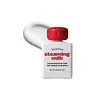What's inside
What's inside
 Key Ingredients
Key Ingredients

 Benefits
Benefits

 Concerns
Concerns

 Ingredients Side-by-side
Ingredients Side-by-side

Water
Skin ConditioningGlycerin
HumectantIsotridecyl Isononanoate
EmollientBis-Diglyceryl Polyacyladipate-2
EmollientOctyldodecanol
EmollientPentylene Glycol
Skin Conditioning1,2-Hexanediol
Skin ConditioningPolyacrylate Crosspolymer-6
Emulsion StabilisingPEG-30 Dipolyhydroxystearate
EmulsifyingOctyldodecyl Xyloside
EmulsifyingPolyacrylate-13
Menthoxypropanediol
MaskingSodium Chloride
MaskingPolyisobutene
Butylene Glycol
HumectantGlyceryl Caprylate
EmollientNarcissus Tazetta Bulb Extract
AstringentPolysorbate 20
EmulsifyingSorbitan Isostearate
EmulsifyingParfum
MaskingTocopheryl Acetate
AntioxidantSodium Hyaluronate
HumectantCamellia Sinensis Seed Oil
HumectantWater, Glycerin, Isotridecyl Isononanoate, Bis-Diglyceryl Polyacyladipate-2, Octyldodecanol, Pentylene Glycol, 1,2-Hexanediol, Polyacrylate Crosspolymer-6, PEG-30 Dipolyhydroxystearate, Octyldodecyl Xyloside, Polyacrylate-13, Menthoxypropanediol, Sodium Chloride, Polyisobutene, Butylene Glycol, Glyceryl Caprylate, Narcissus Tazetta Bulb Extract, Polysorbate 20, Sorbitan Isostearate, Parfum, Tocopheryl Acetate, Sodium Hyaluronate, Camellia Sinensis Seed Oil
Petrolatum
EmollientDimethicone
EmollientMicrocrystalline Wax
Emulsion StabilisingPhytosteryl/Behenyl/Octyldodecyl Lauroyl Glutamate
Skin ConditioningSilica Dimethicone Silylate
AbsorbentDipentaerythrityl Tetraisostearate
EmollientSynthetic Wax
AbrasiveMenthoxypropanediol
MaskingTocopheryl Acetate
AntioxidantCI 77891
Cosmetic ColorantPolyglyceryl-2 Triisostearate
EmulsifyingEthylhexyl Palmitate
EmollientParfum
MaskingTribehenin
EmollientWater
Skin ConditioningSorbitan Isostearate
EmulsifyingHexyl Cinnamal
PerfumingLimonene
PerfumingBHT
AntioxidantLinalool
PerfumingLactic Acid
BufferingTocopherol
AntioxidantButylene Glycol
Humectant1,2-Hexanediol
Skin ConditioningPalmitoyl Tripeptide-1
Skin ConditioningEthylhexylglycerin
Skin ConditioningDisodium EDTA
Hydrolyzed Collagen
EmollientPetrolatum, Dimethicone, Microcrystalline Wax, Phytosteryl/Behenyl/Octyldodecyl Lauroyl Glutamate, Silica Dimethicone Silylate, Dipentaerythrityl Tetraisostearate, Synthetic Wax, Menthoxypropanediol, Tocopheryl Acetate, CI 77891, Polyglyceryl-2 Triisostearate, Ethylhexyl Palmitate, Parfum, Tribehenin, Water, Sorbitan Isostearate, Hexyl Cinnamal, Limonene, BHT, Linalool, Lactic Acid, Tocopherol, Butylene Glycol, 1,2-Hexanediol, Palmitoyl Tripeptide-1, Ethylhexylglycerin, Disodium EDTA, Hydrolyzed Collagen
Ingredients Explained
These ingredients are found in both products.
Ingredients higher up in an ingredient list are typically present in a larger amount.
1,2-Hexanediol is a synthetic liquid and another multi-functional powerhouse.
It is a:
- Humectant, drawing moisture into the skin
- Emollient, helping to soften skin
- Solvent, dispersing and stabilizing formulas
- Preservative booster, enhancing the antimicrobial activity of other preservatives
Butylene Glycol (or BG) is used within cosmetic products for a few different reasons:
Overall, Butylene Glycol is a safe and well-rounded ingredient that works well with other ingredients.
Though this ingredient works well with most skin types, some people with sensitive skin may experience a reaction such as allergic rashes, closed comedones, or itchiness.
Learn more about Butylene GlycolMenthoxypropanediol can cause irritation.
Parfum is a catch-all term for an ingredient or more that is used to give a scent to products.
Also called "fragrance", this ingredient can be a blend of hundreds of chemicals or plant oils. This means every product with "fragrance" or "parfum" in the ingredients list is a different mixture.
For instance, Habanolide is a proprietary trade name for a specific aroma chemical. When used as a fragrance ingredient in cosmetics, most aroma chemicals fall under the broad labeling category of “FRAGRANCE” or “PARFUM” according to EU and US regulations.
The term 'parfum' or 'fragrance' is not regulated in many countries. In many cases, it is up to the brand to define this term.
For instance, many brands choose to label themselves as "fragrance-free" because they are not using synthetic fragrances. However, their products may still contain ingredients such as essential oils that are considered a fragrance by INCI standards.
One example is Calendula flower extract. Calendula is an essential oil that still imparts a scent or 'fragrance'.
Depending on the blend, the ingredients in the mixture can cause allergies and sensitivities on the skin. Some ingredients that are known EU allergens include linalool and citronellol.
Parfum can also be used to mask or cover an unpleasant scent.
The bottom line is: not all fragrances/parfum/ingredients are created equally. If you are worried about fragrances, we recommend taking a closer look at an ingredient. And of course, we always recommend speaking with a professional.
Learn more about ParfumSorbitan Isostearate is an emulsifer and cleaning agent. It is created from isostearic acid and sorbitol.
As an emulsifier, Sorbitan Isostearate prevents oils and water from separating.
Due to its isostearic acid base, it may not be safe for Malassezia or fungal acne.
Learn more about Sorbitan IsostearateTocopheryl Acetate is AKA Vitamin E. It is an antioxidant and protects your skin from free radicals. Free radicals damage the skin by breaking down collagen.
One study found using Tocopheryl Acetate with Vitamin C decreased the number of sunburned cells.
Tocopheryl Acetate is commonly found in both skincare and dietary supplements.
Learn more about Tocopheryl AcetateWater. It's the most common cosmetic ingredient of all. You'll usually see it at the top of ingredient lists, meaning that it makes up the largest part of the product.
So why is it so popular? Water most often acts as a solvent - this means that it helps dissolve other ingredients into the formulation.
You'll also recognize water as that liquid we all need to stay alive. If you see this, drink a glass of water. Stay hydrated!
Learn more about Water